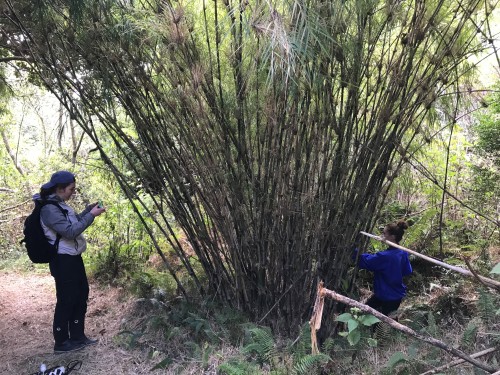
Elizabeth Luotto (L) and Alyssa Risch (R) measure a large bamboo cluster. Alex Morisson not pictured.
Study by Elizabeth Luotto, Alex Morrison, and Alyssa Risch.
In the secondary forest of Cuerici, bamboo appears along the trail in vastly differing sizes, yet they are all the same age due to their cycle of growth, flowering, and simultaneous death. Alder trees are also found frequently in the secondary forest and are known to have nitrogen-fixing bacteria. Bamboo are part of the grass family and therefore are nitrogen intensive. Furthermore, bamboo tend to grow better with better light exposure. With this information in mind, we looked at multiple factors that might affect bamboo growth, defined as stalk number, cluster diameter, individual stalk diameter, and height. We hypothesized that greater canopy cover over the bamboo and a greater distance to the nearest alder tree would negatively correlate with bamboo growth. We also predicted that greater chlorophyll content would correlate with less growth. To test these hypotheses, we sampled fifteen bamboo clusters in the secondary forest. We ran a multiple regression for each growth variable and found that stalk number had a significant positive relationship with distance to nearest alder. We also ran individual linear regressions. The first regression on the dependent variables of individual stalk diameter and stalk number had a significant positive relationship, and the second showed a significant negative relationship between the two independent variables of chlorophyll content and distance to nearest alder. These results do not support our hypotheses, as they predict that bamboo stands closer to alder trees will grow less, but have a higher chlorophyll content. However, the results give information about potential bamboo-alder species interactions which could give insight to future research. We hypothesize that bamboo clusters closer to alder trees may have higher canopy cover, possibly resulting in less sunlight and less growth. The higher chlorophyll content might be due to close proximity to nitrogen-fixing alder. Conversely, clusters further away from alder trees may have lower canopy cover and more sunlight, resulting in more growth.

Artist’s rendition of results from this study.
Leave a comment